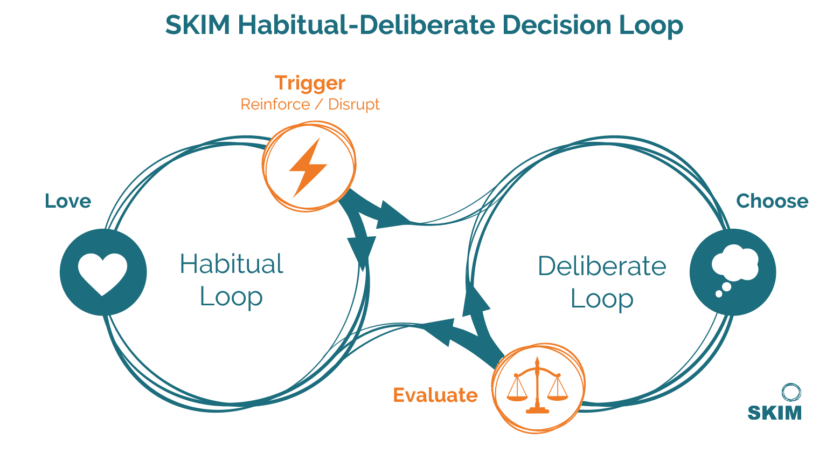The role of empathy and surprise in consumer interactions
Market changes are constant and inevitable. Your competition isn’t slowing down, and you must react quickly and strategically. When information and innovation travel fast, the costs of a late response are high.
Like many marketers today, you’re forced to make fast decisions and quickly adapt brand strategies.
How can you ensure your communications, products, and services deliver on your brand promise – surprising and delighting consumers?
Mistakes may be inevitable when it comes to consumer experiences, but how can you best rectify them?
We recently conducted research to answer these questions and explore the role of emotions in consumer experiences and decision-making.
We discovered that brands that are most successful in mastering consumer experiences understand the importance of emotions, such as surprise and empathy. Armed with a deep understanding of consumer behavior, they know how leveraging emotions can help drive choice and brand loyalty.
Read on to learn more.
What brands need to know about emotions in consumer decision behavior
While some still believe that emotion and reason are completely independent of one another, in fact, they coexist and are codependent. Emotion and reason influence each other in different contexts. When considering emotions in the context of consumer decision-making, keep in mind:
- The Habitual-Deliberate Loop: Is the consumer making a habitual (i.e., repetitive) or deliberate (i.e., considered) decision? Do your marketing strategies need to reinforce those decisions or disrupt them? To trigger the choices, you need to understand what drives behavior at a rational and emotional level.
- The “behavioral steps” of the decision-making journey: Consider all the places where you can actively influence decision behavior. Emotions play a key role in the conscious and subconscious factors influencing that final decision.
Emotions are not only a consequence of decisions; emotions can drive consumer decisions by pushing them towards action.
Research highlights: Emotions and consumer brand interactions
We conducted a hybrid qualitative-quantitative research study to understand if interactions with a brand can provoke strong positive or negative emotions in consumers. Considering the cross-cultural differences in emotional experiences, we surveyed British, Dutch, and Indian consumers because they tend to be quite significantly different across various cultural dimensions, which then allowed us to see patterns that can be found globally (N=449).
What did we learn?
- Delivering more than the “basics” prompts positive emotions in consumers, most often surprise and delight
- Positive emotions drive brand loyalty
- Mistakes in interactions with consumers produce strong negative emotions in consumers, most often anger and disappointment
- Negative emotions result in switching and retaliatory behaviors
- Surprisingly, initially bad interactions can be turned around by showing empathy to consumers, resulting in positive emotions and brand loyalty
Want to dive deeper into the research? Contact us

Insight #1
How brands can deliver consumer experiences “beyond the basics”
When does an average experience cross over to an extraordinary (tipping point) one?
Consumers enter interactions with brands with a set of expectations based on familiarity or previous experience with the brand. Some brands successfully manage these expectations, for example, by letting consumers know when their package will be delivered or when their driver will pick them up.
A tipping point experience, on the other hand, means that you have exceeded these expectations by adding more value to the basic experience. This interaction leaves the consumer feeling grateful and pleasantly surprised.
“Weeks after we bought a new laptop, a key on the keyboard popped out and we were unable to fix it. We contacted X who said to bring it in where we received the most exceptional service. The laptop was replaced, the staff backed up all our files and told us to have lunch on them while we waited. In the end, we were handed a £40 voucher in lieu of the petrol we had used to go to the store.” Female, UK
Offering consumers something beyond the basics, such as sending a birthday gift or message, can strengthen your relationship with them. This added value evokes loyalty and makes consumers more likely to engage in positive word-of-mouth.
Theory behind practice
According to the reciprocity norm, the (sub)conscious decision to become loyal is the consumer’s way of showing appreciation towards your brand. The norm suggests that, in their interactions with others, people tend to respond to another’s action with an equivalent reaction. Therefore, if you do something amazing for a consumer, they are likely to feel obliged to do something amazing for you.
Insight #2
How brands can “bounce back” from a negative consumer experience
How to turn an initially bad experience into an extraordinary one?
A negative interaction with a consumer does not have to end your relationship. However, a failure to fix the mistake can infuriate a consumer, urging them to retaliate against your brand. Consumers expect an apology after a transgression because you owe it to them.
By showing empathy for the unpleasant occurrence and going the extra mile to make it up to them, you can ensure that your relationship grows stronger than ever.
“My mother got food poisoning and realized the fruit she’d eaten was rusty. She complained and they apologized and sent vouchers. The next day, the manager of the store turned up on my mum’s doorstep with a bag full of shopping treats. We were so astonished that before that, she went to this store occasionally, but now she’s a regular.”
Female, United Kingdom
Investing in consumers’ experiences and going above and beyond is likely to result in consumers going the extra mile for you too, simply to express their gratitude.
Theory behind practice
Without proper care, bad experiences escalate in the minds of consumers. According to the negativity bias, people experience and dwell on negative stimuli more intensely. Generally, negative emotions require more mental effort to minimize the consequences of negative events, making them more memorable.
Emotions and decision behavior: What does this all mean for your brand?
Emotions are a strong driver of consumer behavior. Understanding the importance of surprise and empathy means developing strategies and taking actions that align with the genuine needs and wants of your consumers. For example:
- Before positively surprising your consumers, make sure you answer the following questions:
- What expectations do consumers hold from me and how can I surpass them in a meaningful way?
- Am I choosing to surprise my consumers because I’m unable to deliver on my basics? Be aware of proceeding if the answer is Yes!
- Is this additional factor that I am offering something that I can continuously offer? If it is a one-time thing, am I making it clear enough for the consumer?
- Empathy is being able to understand how a person is feeling and what they might be thinking in a situation. This insight can dictate your actions. This means a chance to genuinely humanize your interactions with consumers. Our research indicates going the extra mile for consumers whom you’ve wronged by taking responsibility, sincerely apologizing, and offering thoughtful and personalized compensation could even increase loyalty.
Research implications: Measuring emotions
If tapping into emotions is key to mastering consumer interactions and driving decision behavior, how can you better measure emotions? Depending on the business issue or research question you’re tackling, there are various tools and techniques we recommend:
- Voice analytics can understand levels of emotional arousal by analyzing pitch and amplitude. These artificial intelligence (AI) tools that reveal subconscious emotions and unbiased reactions can help combat the overstatement of interest.

- Body posture can be used to measure the behavioral component of a person’s emotions in a noninvasive approach
- Facial expressions tools can be used to mitigate the shortcomings of self-report measures. Software programs can capture the expression of an emotion as it occurs in real-time settings.
—
Today, being empathetic and surprising consumers is becoming a competitive requisite and might just be your secret weapon; use it!
Please reach out if you’d like to know more about how to tap into emotions to influence consumer decisions.
Acknowledgements
Special thank you to Jennifer Agbenyo and Andrea Podobnik for their contributions to this article
Jennifer Agbenyo is a Research Analyst at SKIM, based in the Rotterdam office. Her background is in Economic and Consumer Psychology from Leiden University. She is especially passionate about consumer attitudes and behavior, with a focus on how culture can impact consumer decision-making.
Andrea Podobnik is a Senior Research Analyst, based in SKIM’s London office. She has a passion for consumer behavior and behavioral economics. She holds a Master’s degree in Social and Organisational Psychology and a Master’s degree in Economics and Business.


